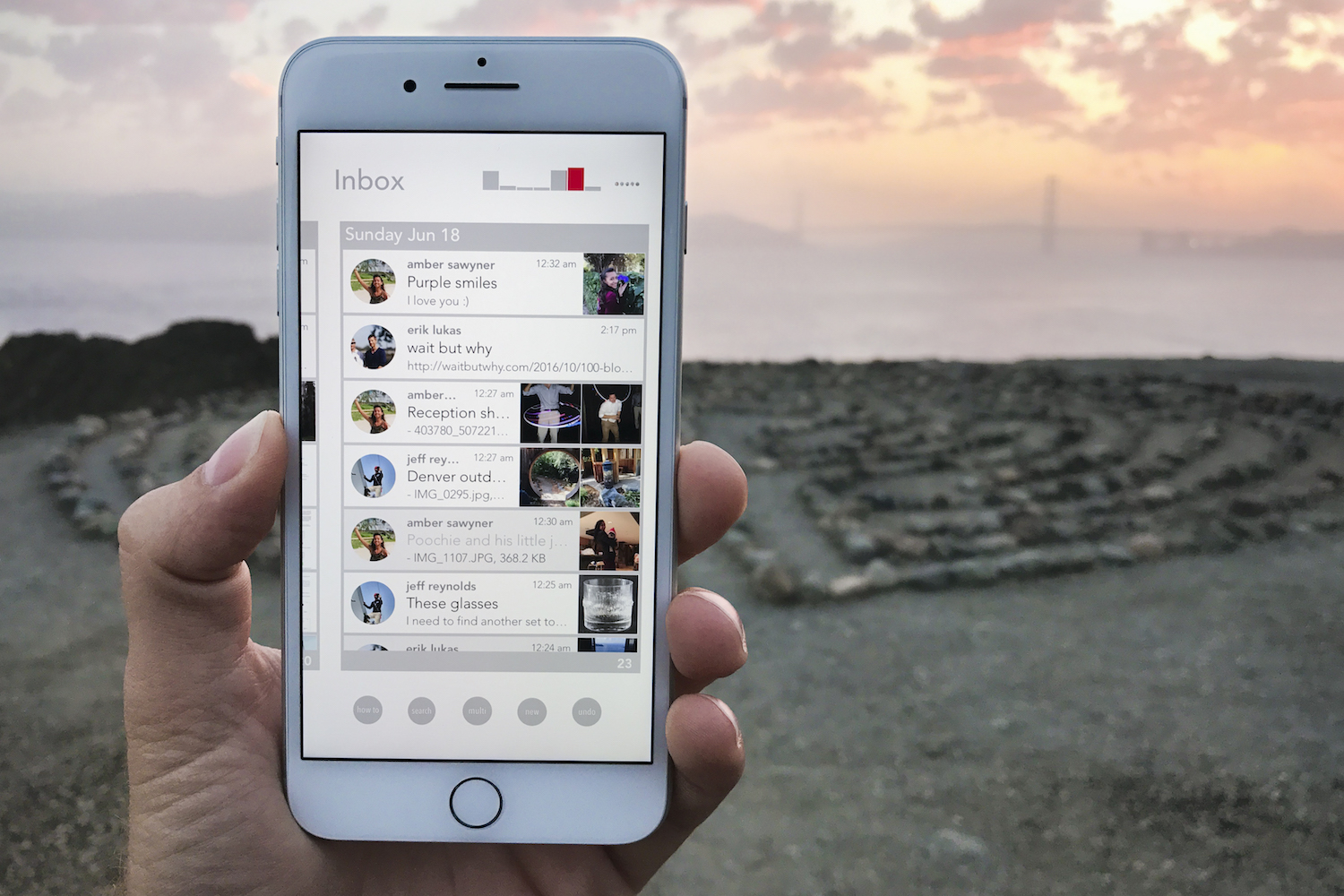It’s a constant refrain. Today’s email is a tragedy and a travesty. There’s no way to sort information in personally relevant ways, few tools that can organize the mass of messages rolling in through an increasingly ubiquitous scroll of information in a vertical list format.
Erik Lukas, the founder of Jumpin Labs, has a different vision for what email should look like.
Instead of the ceaseless stream of subject lines and previews, Jumpin Labs’ app Geronimo rethinks the entire way email is organized, managed, stored and presented on a mobile device (specifically the iPhone — for now).
The release marks the second act for Jumpin Labs, which has been focused on developing a better email to make people fitter, happier, and more productive since launching in 2015.
When the product first launched, Lukas’ startup drew rave reviews from most tech sites and was able to quickly raise cash. But the back-end architecture Jumpin Labs used collapsed under the weight of its feature set and the company had to go back to the drawing board.
Two years later, Lukas is finally ready to reintroduce Geronimo to the world.
And while the rest of the technology world has seen huge shifts in the two years that Geronimo was back in the lab, email, unsurprisingly, remains stubbornly unchanged.
Since 2014, the biggest innovations from the major email platforms has been the automated contextual response and the ability to swipe a message into an archived folder.
It’s almost shocking how little attention is paid to what remains one of the most important productivity tools out there. Instant messaging may be buzzier, but that’s because email has become almost an afterthought — even while it remains so, so broken.
“Email hasn’t evolved much since 1999. Our phones get more advanced every 6 months but email has been painfully stagnant,” said Lukas in a statement.
New features in the updated Geronimo app include an ability to annotate videos and images in the app, an undo send feature and its location exclusively on a users’ phone (this clientside architecture means that data stays private and isn’t moving through yet another company’s servers). All this on top of the company’s initial innovations like a horizontal timeline view; the ability to select and move individual emails, and customizable corners where email can be deleted, archived, put in a to-do list, or save til later.
Like Superhuman, which is in a private beta throughout these dog days of summer, Geronimo’s purpose is to remake email in a better image, using more powerful tools and a better organizing principle.
But instead of focusing on the hardcore business user, Geronimo is bringing its array of bells and whistles, and its much improved user interface to the masses.
Lukas’ app isn’t for everyone. Ludicrous email addicts (like yours truly, whose inbox is an existential nightmare) may actually overwhelm and break the app — but I’m assuming that’s an outlier (how many people have over 29,000 unread emails in their inbox?) and Lukas assured me he’s working on it.
It’s a problem that Lukas has been working on since 2015 when his company raised its initial capital from investors like Draper Associates.
Geronimo is one aspect of a future that Lukas envisions for the app that’s still at the heart of most business interactions.
From payment options for receiving emails to new ways to organize and share mail, the future of mail as a productivity tool is still largely unwritten and it’s interesting to see companies like Geronimo and Superhuman trying to fix a broken system.

Lukas firmly believes that email will be paid. “I believe that the advent of micro-transactions we’re about to experience around a rebuilding of the attention economy and how platforms will compensate creators will create the side benefit of a paid email system,” Lukas wrote in an email.
Companies like 21.co (the former bitcoin mining hardware developer) and the now-defunct Goodmail offer variants of the pay-to-read and pay-to-send model of email that put a value on the reader’s time and inbox bandwidth.
“There will undoubtedly be entire email replacement messaging platforms build on immutable blockchain tech because it’s an experiment that has to be done but I don’t think there are as many benefits to that as simply having merchants pay to communicate with users and users be compensated at a rate they choose for their precious time,” according to Lukas.
Shareability is another feature that Lukas expects to see in the new world of email. He pointed to apps like Front, which allows business teams to share email threads. However, Lukas would like to see these enterprise tools expanded to consumers — to improve email for everyone.
Roughly 3 billion people have an unwieldy stream of messages coming into their inboxes daily, and those messages should be more programmable, Lukas said (including hashtag permissions that would put certain messages with topics or from senders at the top of the inbox).
“Interaction ideas are currently relatively stagnant with new entrants unmotivated to innovate in the email space vs other proprietary protocol options due to challenging breakout success demands,” Lukas wrote to me. “The opportunity cost of having a high level team innovate and create new interfaces that interact directly with imap is high in a world of cryptocurrency interest and [artificial intelligence applications] in the enterprise.”

The history of email is littered with failed and half-hearted attempts to reinvigorate the technology, from IBM’s reinvented email prototype, remail; to the Bifrost inbox organizer; or the time researchers at the University College of Dublin, University of Pennsylvania, and IBM tried to organize email into a set of activities.
Predictive technologies can be used to help determine if someone will reply to a message; can inform users of mistakes they’ve made in their replies and automate some responses; and can visualize relationships of people from their conversational histories. These tools are amazing, but Lukas thinks the industry can go farther.
“This is an area that involves information sorting and how we deal with and mismanage our priorities and it affects 3.7 billion people around the world,” he wrote. “Google and Microsoft would love to see email as a software problem, as something where a model for sorting on their end improves efficiency by batching chunks of emails and suggesting short replies. That’s a valid end of the spectrum to improve but there is the other end of the spectrum which gives users more control, which empowers them to be faster, sort better, and prioritize according to what they know is best.”
[gallery ids="1532292,1532293,1532294,1532295,1532296,1532297"]
